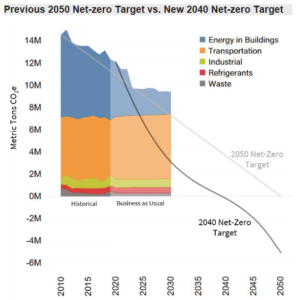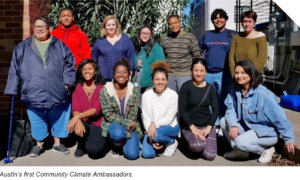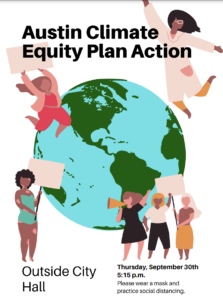In Support of the Austin Climate Equity Plan
By Kaiba White
 As the daily reminders of the perils of climate change keep coming, the Austin Climate Equity Plan is finally scheduled for a vote at City Council on September 30.
As the daily reminders of the perils of climate change keep coming, the Austin Climate Equity Plan is finally scheduled for a vote at City Council on September 30.
While there is no suspense about the outcome of the vote (there is broad support for the plan), this is an exciting moment coming two years after development of the plan began.
Austin has long been a leader on climate action, adopting the Austin Climate Protection Plan in 2007 and the Austin Community Climate Plan in 2015. When it was adopted, the Community Climate Plan was considered bold. It encompasses not just emissions that the city controls, but all emissions from the Austin community. It includes more than 100 action items to reduce emissions to reach the goal of net-zero emissions by 2050 or sooner, if possible. The Austin City Council has also set ambitious goals for the city’s electric utility – Austin Energy – to transition to renewable energy. The Austin Climate Equity Plan is the logical next step to maintain this leadership.
 With the adoption of a new plan, Austin will set a new goal of reducing local climate pollution to net-zero by 2040, with a strong emphasis on cutting emissions by 2030. While “net-zero” doesn’t mean “zero,” the plan also makes clear that emissions offsets are the least desirable option and are to account for no more than 10% of the needed emissions reductions. This new goal will make Austin a clear leader among U.S. cities and is more similar to goals set by European cities that are taking climate change seriously. This goal is supported by reports by the Intergovernmental Panel on Climate Change and C40 Cities methodology for city climate planning. The intention is for the Austin community to do our part to keep global temperature increase to as close to 1.5°C as possible. Warming beyond that level will cause serious ecosystem and societal disruption.
With the adoption of a new plan, Austin will set a new goal of reducing local climate pollution to net-zero by 2040, with a strong emphasis on cutting emissions by 2030. While “net-zero” doesn’t mean “zero,” the plan also makes clear that emissions offsets are the least desirable option and are to account for no more than 10% of the needed emissions reductions. This new goal will make Austin a clear leader among U.S. cities and is more similar to goals set by European cities that are taking climate change seriously. This goal is supported by reports by the Intergovernmental Panel on Climate Change and C40 Cities methodology for city climate planning. The intention is for the Austin community to do our part to keep global temperature increase to as close to 1.5°C as possible. Warming beyond that level will cause serious ecosystem and societal disruption.
The Austin Climate Equity Plan is more than just a plan to reduce emissions though. As the name implies, this plan centers equity as a core outcome, along with reducing emissions. Those of us who worked to craft the plan decided at the start that equity must be prioritized, partially because it’s the right thing to do and partially because meeting the community-wide goal isn’t possible without widespread participation of the community.
Everyone should have access to clean air and water and affordable and healthy housing food and other products. Eco-friendly goods and services shouldn’t just be for the middle and upper classes. Likewise, the jobs and other economic benefits that come with the transition to a low-carbon future should be accessible to all, especially those who have been excluded from the benefits of our current polluting system.
With equity established early on as a core theme, creation of the Austin Climate Equity Plan included some elements that haven’t been part of any past city planning that I’ve been part of. To start, the Joint Sustainability Committee (a volunteer advisory body) worked with the Office of Sustainability and the Equity Office to recruit a diverse group of community members to serve on a Steering Committee and five working groups (Sustainable Buildings, Consumption, Transportation and Land Use, Electric Vehicles and Natural Systems).
 All participants were required to take an all-day equity workshop to learn about the history of racist policies in Austin and how to work against the systemic racism that remains today. A Climate Ambassador program was created to pay community organizers to have conversations about climate change and priorities for the plan within their communities. The Steering Committee created an equity screening tool used to evaluate the plan’s goals and strategies. If a goal or strategy didn’t score well in the equity tool, the working group would come up with ways to overcome barriers or create alternate pathways to achieve the same goal.
All participants were required to take an all-day equity workshop to learn about the history of racist policies in Austin and how to work against the systemic racism that remains today. A Climate Ambassador program was created to pay community organizers to have conversations about climate change and priorities for the plan within their communities. The Steering Committee created an equity screening tool used to evaluate the plan’s goals and strategies. If a goal or strategy didn’t score well in the equity tool, the working group would come up with ways to overcome barriers or create alternate pathways to achieve the same goal.
All of this took a lot of work, but the result is a plan that was created by a diverse group of Austinites that lays out a wide array of strategies to both reduce climate pollution and improve equity in our community. It was worth every meeting and every email, and this is just the start.
Implementing the Austin Climate Equity Plan is where the dreams will hopefully start to become reality. There’s no time to waste. The City Council will vote on an implementation resolution on September 30, as well voting on the plan itself. The details of the resolution are still being worked out, but the Steering Committee and the Joint Sustainability Committee are supporting a few priority actions:
 Direct the city manager to work with a community working group to identify priorities for the mid-year budget update in the spring of 2022 and the next full budget for fiscal year 2023;
Direct the city manager to work with a community working group to identify priorities for the mid-year budget update in the spring of 2022 and the next full budget for fiscal year 2023;- Create a new council committee that will oversee implementation of the plan, as well as other environmental justice issues; and
- Add more members to the Joint Sustainability Committee to increase diversity and add capacity to do the needed work.
The Austin Climate Equity Plan holds exciting promise for our city. Join us at 5:15 on September 30 at City Hall for a rally to celebrate the new plan and build momentum for implementation.